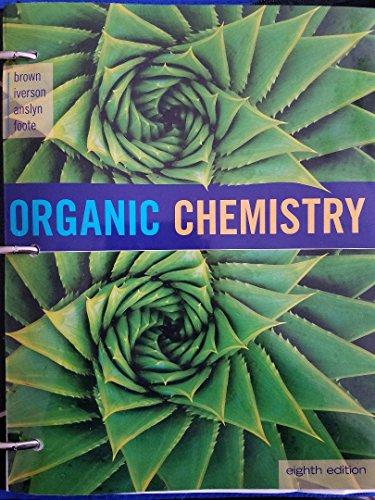
Interpretation:
Conversion of toluene to 3-hydroxybenzoic acid has to be shown.
Concept introduction:
Nitration: In nitration reaction, one nitro group
Oxidation: If electrons are moved from a species or oxygen atoms are added to a species or hydrogen atom gets removed from a species during a
Conversion of
Aromatic amines converted to arenediazonium salt by reacting with
Reduction: If electrons are gained to a species or hydrogen atoms are added to a species or oxygen atom gets removed from a species during a chemical reaction is known as reduction. In a reaction,
Trending nowThis is a popular solution!

Chapter 23 Solutions
Organic Chemistry, Loose-leaf Version
- A problem often encountered in the oxidation of primary alcohols to acids is that esters are sometimes produced as by-products. For example, oxidation of ethanol yields acetic acid and ethyl acetate: Propose a mechanism to account for the formation of ethyl acetate. Take into account the reversible reaction between aldehydes and alcohols:arrow_forwardاسئله امتحان الفيزیاويه -> ... Physical Chemistry Q1) In this reaction CH,COOCH, + H,0 - CH,COOH + CH,OH Note that the rate and order of the rection depend only on the concentration methyl acetate , Explaine this ? Q2) Hydrolysis of as ester under basic conditions is called Saponfaction, Why? Q3) In the reaction of hydrolysisof the ester with the base ,it was observed that the Conductivity of the reaction mixture decreased with time ,Explain it ? Q4) In an experiment, Sucrose was dissolved into glucose and fructose using a dilute acid ,therotation angles at different times were as follows: t(min) 30 41 150 330 2.75 630 -10 00 -18.75 a 46,75 22 Calculate the rate constant of the reaction ?arrow_forwardusing your knowledge in hydrocarbon chemistry, propose a reaction to convert 1-pentene into at least 6 other branched hydrocarbon compound that are consisting of 6 carbon atoms or more in their structure. write complete mechanism and steps. show all assumptions if any. you may use one or direct reaction or a combination of reaction to produce each product.arrow_forward
- The question is: "Draw the curved arrow mechanism for the reaction between pentan-2-one and (CH3)3O– in t-butanol to form an enolate. Draw all electrons and charges on both resonance structures. Then answer the question about the reaction." I got the initial arrows correct, but am not entirely sure what the carbanion intermediate would look like and then what the curved arrows would be to convert it to its final oxanion formarrow_forward3. Nucleophilic aromatic substitution (NAS) reactions have the opposite trend in terms of reaction rate when compared with SN2 reaction rates. This is to say that aromatic fluorides undergo substitution the fastest under NAS conditions but the slowest under SN2 conditions. Using your knowledge of the mechanisms of these reactions, explain why this is the case. (Hint: It is important to consider the rate-determining step of each mechanism). NuO Nu Rate of reaction follows the following trend: F> CI > Br>1 NuO Nu Rate of reaction follows the following trend: I> Br > CI >Farrow_forwardDraw the mechanism of the hydration and the enol ketone tautomerization reaction using one of the alkynes in calicheamicin. Use the formal arrow pushing formalism and show the product of this hydration.arrow_forward
- Why is the product only methyl 3-nitrobenzoate? Hint: why does nitration occur in the meta position only?arrow_forwardAnalyze the different substitution products formed in case of furan when it is reacted with iodine. Write the reaction mechanism involved when furan reacted with iodine and evaluate the formation of products.arrow_forwardShow the complete synthesis for the following reaction that forms the following product(s) PLEASE INCLUDE STRUCTURE AND REAGENTarrow_forward
- Draw a mechanism for the conversion of glucose from its aldehyde form to its hemiacetal form and then to its methyl glycoside (acetal) form under acidic conditions. Show all bond breaking and bond forming steps; show all intermediates.arrow_forward(b) Consider the reaction of 1-bromobutane with a large excess of ammonia (NH3). Draw the reactants, the transition state, andthe products. Note that the initial product is the salt of an amine (RNH3+ Br - ), which is deprotonated by the excess ammonia to give the amine.arrow_forwardThe relative rates of reaction of ethane, toluene, and ethylbenzene with bromine atoms have been measured. The most reactive hydrocarbon undergoes hydrogen atom abstraction a million times faster than does the least reactive one. Arrange these hydrocarbons order of decreasing reactivity.arrow_forward
 Organic ChemistryChemistryISBN:9781305580350Author:William H. Brown, Brent L. Iverson, Eric Anslyn, Christopher S. FootePublisher:Cengage Learning
Organic ChemistryChemistryISBN:9781305580350Author:William H. Brown, Brent L. Iverson, Eric Anslyn, Christopher S. FootePublisher:Cengage Learning Organic Chemistry: A Guided InquiryChemistryISBN:9780618974122Author:Andrei StraumanisPublisher:Cengage Learning
Organic Chemistry: A Guided InquiryChemistryISBN:9780618974122Author:Andrei StraumanisPublisher:Cengage Learning Chemistry for Today: General, Organic, and Bioche...ChemistryISBN:9781305960060Author:Spencer L. Seager, Michael R. Slabaugh, Maren S. HansenPublisher:Cengage Learning
Chemistry for Today: General, Organic, and Bioche...ChemistryISBN:9781305960060Author:Spencer L. Seager, Michael R. Slabaugh, Maren S. HansenPublisher:Cengage Learning



